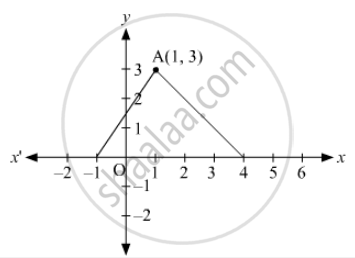Advertisements
Advertisements
Question
If points Q and reflections of point P (−3, 4) in X and Y axes respectively, what is QR?
Solution
We have to find the reflection of (−3, 4) along x-axis and y-axis.
Reflection of any pointP(a, b) along x-axis is( a , b)
So reflection of (−3, 4) along x-axis is Q ( -3 , - 4)
Similarly, reflection of any point P ( a , b) along y-axis is ( -a , b)
So, reflection of (−3, 4) along y-axis is R ( 3 , 4)
Therefore,
`QR = sqrt ((3 + 3)^2 + ( 4 + 4)^2)`
` =sqrt(36+ 64)`
` = sqrt( 100) `
`= 10 `
APPEARS IN
RELATED QUESTIONS
If A(–2, 1), B(a, 0), C(4, b) and D(1, 2) are the vertices of a parallelogram ABCD, find the values of a and b. Hence find the lengths of its sides
Let ABCD be a square of side 2a. Find the coordinates of the vertices of this square when A coincides with the origin and AB and AD are along OX and OY respectively.
The three vertices of a parallelogram are (3, 4) (3, 8) and (9, 8). Find the fourth vertex.
In Fig. 14.36, a right triangle BOA is given C is the mid-point of the hypotenuse AB. Show that it is equidistant from the vertices O, A and B.

We have a right angled triangle,`triangle BOA` right angled at O. Co-ordinates are B (0,2b); A (2a, 0) and C (0, 0).
Find the third vertex of a triangle, if two of its vertices are at (−3, 1) and (0, −2) and the centroid is at the origin.
A (3, 2) and B (−2, 1) are two vertices of a triangle ABC whose centroid G has the coordinates `(5/3,-1/3)`Find the coordinates of the third vertex C of the triangle.
If A and B are (1, 4) and (5, 2) respectively, find the coordinates of P when AP/BP = 3/4.
In what ratio does the point (−4, 6) divide the line segment joining the points A(−6, 10) and B(3,−8)?
If the points p (x , y) is point equidistant from the points A (5,1)and B ( -1,5) , Prove that 3x=2y
The line segment joining the points A(3,−4) and B(1,2) is trisected at the points P(p,−2) and Q `(5/3,q)`. Find the values of p and q.
In what ratio does y-axis divide the line segment joining the points (-4, 7) and (3, -7)?
The midpoint P of the line segment joining points A(-10, 4) and B(-2, 0) lies on the line segment joining the points C(-9, -4) and D(-4, y). Find the ratio in which P divides CD. Also, find the value of y.
If the centroid of the triangle formed by points P (a, b), Q(b, c) and R (c, a) is at the origin, what is the value of a + b + c?
Write the coordinates the reflections of points (3, 5) in X and Y -axes.
If points (a, 0), (0, b) and (1, 1) are collinear, then \[\frac{1}{a} + \frac{1}{b} =\]
The ratio in which the line segment joining P (x1, y1) and Q (x2, y2) is divided by x-axis is
If the line segment joining the points (3, −4), and (1, 2) is trisected at points P (a, −2) and Q \[\left( \frac{5}{3}, b \right)\] , Then,
In Fig. 14.46, the area of ΔABC (in square units) is

Point (–3, 5) lies in the ______.
Seg AB is parallel to X-axis and coordinates of the point A are (1, 3), then the coordinates of the point B can be ______.
